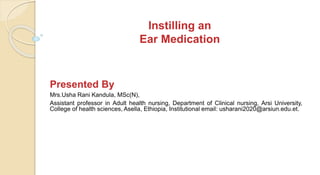
Instilling ear medication.pptx
- 1. Instilling an Ear Medication Presented By Mrs.Usha Rani Kandula, MSc(N), Assistant professor in Adult health nursing, Department of Clinical nursing, Arsi University, College of health sciences, Asella, Ethiopia, Institutional email: usharani2020@arsiun.edu.et.
- 2. EAR MEDICATIONS -Solutions ordered to treat the ear are often referred to as otic (pertaining to the ear) drops or irrigations. -Eardrops may be instilled to soften ear wax, to produce anesthesia, to treat infection or inflammation, or to facilitate removal of a forgien body, such as an insect. -External auditory canal irrigations are usually performed for cleaning purposes and less frequently for applying heat and antiseptic solutions.
- 3. -The internal ear is very sensitive to changes in temperature. -Sudden changes can cause nausea and dizziness. - Eardrops and irrigation fluids should be at room temperature. -Before instilling a solution into the ear, the nurse should inspect the ear for signs of drainage, an indication of a perforated tympanic membrane.
- 4. -The internal ear is very sensitive to changes in temperature. -Sudden changes can cause nausea and dizziness. - Eardrops and irrigation fluids should be at room temperature. -Before instilling a solution into the ear, the nurse should inspect the ear for signs of drainage, an indication of a perforated tympanic membrane.
- 5. -Eardrops are usually contraindicated when the tympanic membrane is perforated. -If the tympanic membrane is damaged, all procedures must be performed using sterile aseptic technique; otherwise, medical asepsis is used when instilling medications into the ear. -Medication should never be forced into the ear canal especially if it is occluded (as by wax).
- 6. -Forcing medication into an occluded eardrum can injure the eardrum. -Certain conditions have contraindications for specific drugs; for example, hydrocortisone eardrops are contraindicated in clients with a fungal infection or a viral infection such as herpes.
- 7. Equipment Medication administration record (MAR) Cotton-tipped applicator Cotton balls Medication Non sterile gloves Tissue
- 9. Sl.No Action Rationale 1 Check with client and chart for any known allergies. Prevents the occurrence of hypersensitivity reactions 2 Check the MAR against the health care practitioner’s written orders. Ensures accuracy in identification of the medication. 3 Wash your hands. Reduces the transfer of microorganisms. 4 Calculate the dose. Ensures the administration of the correct dose. 5 Use the identification armband to properly identify the client. Ensures correct client. 6 Explain the procedure to the client. Enhances cooperation.
- 10. Sl.No Action Rationale 7 Place the client in a side-lying position with the affected ear facing up. Facilitates the administration of the medication. 8 Don non sterile gloves. Decreases contact with body fluid. 9 Straighten the ear canal by pulling the pinna down and back for children or upward and outward for adults (Figure 29-35). Opens the canal and facilitates introduction of medication. The external ear structures of adults and children are different. If the ear canal is not straightened properly, medication may not reach the deep inner ear structures. 10 Instill the drops into the ear canal by holding the dropper at least 1/2 inch above the ear canal. Prevents injury to the ear canal.
- 11. Sl.No Action Rationale 12 Place a cotton ball on the outermost part of the canal. Prevents the medication from escaping when the client changes to a sitting or standing position. 13 Wash hands. Reduces the transmission of microorganisms. 14 Document the drug, number of drops, time administered, and the ear medicated. Documenting the actions of the nurse will reduce the number of medication errors. 15 Evaluate the condition of the skin in the outer ear between instillations. Determines possible skin reaction. Thanking you